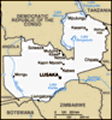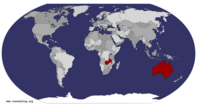Advertisement
Upon arrival in South Africa, I was greeted with a stunning red sunset & a cracking lightning storm. Apparently, Johannesburg has a very high occurrence of lightning due to the gold in the ground. The discovery of gold is what created Jo’burg & evidence of this mining is still visible around the city with mining rigs & remanent sand hills. With no river, mountains nor ocean to contain it, Jo’burg is a sprawling city. Despite being the largest city & having the major international airport, surprisingly it’s not the capital – nor the legislative which is Cape Town, nor the administrative which is Pretoria, nor the judicial which is Bloemfontein. It does have the highest court though.
To get to the Airbnb flatlet, we passed thru 2 boom gates with armed guards. The neighbourhood is double fenced, topped with spikes. It is an affluent area however with the additional high walls around individual residences & signs of 24/7 armed security, I didn’t feel the humanity. The following day, I was taken to Soweto by Ilan, an Israeli South African photojournalist where there was little in the way of security, humanity was everywhere, and I felt safe walking there. Maybe that
was because everyone knew Ilan including the little kids who would come running to give him a hug; occasionally I got one too. Ilan supports programs in the informal settlement there.
One of the programs provides music education to the children and I was fortunate to see evidence of this thru bongo playing by the children on the streets as part of play, a trio of young men singing with a guitar & another young trio of KG, Sunny Boy & Linda called Good KGB using bongo drums & voice with a very energetic performance. Such positive sound & energy.
During the days of apartheid, Ilan would sneak into Soweto to photographically capture life there. It’s difficult to hear of the history of Soweto’s establishment – the government moving all blacks to a newly built settlement
South
West of
Town, approximately an hour from Jo’burg. There they had no running water, no indoor toilet, no electricity. Night light was provided by way of tall flood lights over the area. The residents of Soweto provided a lot of service jobs to the white residents of Jo’burg – still do. To attend to those jobs, they had to carry passbooks
to prove their employment status as blacks weren’t allowed in Jo’burg otherwise.
Minivans provide transportation to many of the 3M+ residents of Soweto. To determine where a minivan is going or to communicate where you want to go, there’s a collection of hand signals. Closed fist = Jo’burg, index finger pointing skyward = train station or something like that. A great method to cut through the various languages used by passengers. Unfortunately, during COVID restrictions, the train stations & overhead wires were stripped. As a result, the train services are unable to operate and there is now a proliferation of minivans (all Toyota model). The taxi depot in Soweto went on & on for blocks.
Since apartheid was abolished & more so since Nelson Mandela passed, crime has become a significant issue. Unemployment which was 25%!p(MISSING)rior to the pandemic is now 33%!,(MISSING) amongst the highest in the world. Driving around, the roads are in disrepair, I saw little police presence & was informed corruption –
cold drink – is rife. Load shedding is a significant problem – residents refer to an app that shows times of load shedding for their area. At my accommodation, there was 3
sessions within one day for a total of 8 hours. The Airbnb has invested in solar panels, small batteries to run critical things, gas cooker and heater as well as rechargeable lights. When I was at the phone shop, there was no electricity. It must be brutal for businesses. In the neighbourhood, you could hear generators running – very noisy in a quiet neighbourhood.
Driving to the airport, the Airbnb host Lesley spoke about the unconscious stress of the security of which she doesn’t notice till travelling internationally to places where she can safely walk down the street at night – something she wouldn’t do at home by herself in her double boom gated neighbourhood. Les likened it to the crab boiling in the pot. She came to South Africa from Scotland with her family after the Thatcher government brought industry back to England making her father redundant. Being 13 she didn’t want to come; now she’s the last of the family there. Despite the issues, she loves the country –
It’s so beautiful. I won’t see much unfortunately as it’s off to Livingstone, Zambia via Victoria Falls, Zimbabwe for tour start.
Landing into Victoria Falls airport, I
could see the spray of Victoria Falls (Mosi-Oa-Tunya) from 20
+km away. (
Ed note: Mosi-Oa-Tunya means The Smoke that Thunders.) Passing through Zimbabwean immigration is an experience, a slow one. Whilst waiting for the line to move at a snail’s pace (
Ed note: the snail might win), I chatted to the couple behind me. The gentlemen had lived in the country for 20 years previously and advised that the Zimbabweans never got rid of the English bureaucracy.
However, this is the worst of it, he said.
Get through this and the people are fabulous.
Visa in hand, I head to the border to cross into Zambia which is across the famous single laned Victoria Falls Bridge built in 1905. The bridge is in ‘no man’s land’ between the 2 border posts as the Zambezi River is the natural border between the two countries. The taxi driver allowed us to walk across the bridge for the first glimpse of the falls – the 7
th natural wonder. At the Zambian border post, there was a baboon happily munching through a bag of biscuits that hadn’t been secured out of reach. Turning off the main road to the campsite, there’s a zebra on
the verge munching on the grass. Welcome to Africa.
At camp, it was straight into the tour meeting where I met my fellow travellers – 11 in total with Zimbabwean Gee & Ishmael as the Guide & Driver respectively. Preliminaries done, it was off to book next day activities before heading to the Zambian side of the falls. And what an experience that is. In May, the falls are at their most voluminous. Nearly 1 million litres per second falls 108m over the 1.7km wide precipice into a zigzagging gorge. The Zambian side allows you to stand opposite the top of the falls, approximately 10-20m away, providing an up-close experience of the water’s power. The spray from Knife Edge Bridge out to Danger Point has you drenched many times over. Think that for a moment, the water falls 108m, then some, a rather lot at the moment, rebounds over 108m up past the height of the falls to be seen over 20km away and then down again onto the adventurous souls who take the walk past the raincoat shop & onward to Danger Point. The returning people are so drenched I thought they had taken a swim at the
bottom of the falls on this warm day.
Dinner that night at a local restaurant in Livingstone, Café Zambezi, I had the signature cocktail – refreshing – along with fried caterpillar – interesting – though neither are likely to appear on the home menu. Over dinner, getting to know the fellow travellers, I discover I’m the only native English speaker. There’s 4 Germans, an Austrian, an Italian, a Greek & a German Australian. Thankfully they all speak English very well.
The next morning Eva & I set off on a bicycle tour around 3 local Livingstone villages. It was Sunday and there were lots of people out & about, walking around and between villages including those heading to the many religious services taking place – Christianity is the main religion. We stopped by a local market with produce, clothing & hardware for purchase. We tried baobab fruit – which can be sucked on like a lolly, made into a drink as well as a porridge. There was also a stall for freshly made roasted peanut butter & a milling centre for locals to bring their maize.
The first village, furthest from Livingstone, Malone, has increased significantly since
the pandemic as residents from town who couldn’t afford the rent with the loss of tourism from border closures moved out. Non-living area buildings are predominantly made of logs from local butterfly leaf tree – can’t remember proper name. The gaps between are filled in with mud & a thatched roof placed on top. Living area buildings are predominantly made with brick & concrete & topped with a tin roof weighted down with large rocks. There is maize growing on most blocks from which polenta is made and used with most meals – it’s heaviest helps keep bellies feeling full. For those without income, one task that can be done to is crushing rocks into small stones to be used in the construction of roads & houses – a wheelbarrow of stones fetches USD50c – difficult work for little money.
As we got closer to Livingstone, the villages got a little bit more affluent with more permanent buildings and business including bars, tuckshops – convenience stores & hair salons as well as better dirt roads. It was a great morning exploring by bike & seeing life in this part of Zambia.
To reward my morning’s exertions, I had
a late lunch of crocodile kebabs & a cocktail, African Lady – like a Tequila Sunrise – at the campsite’s restaurant overlooking the Zambezi River and proceeded to while away the gorgeous afternoon watching the sun set over the water. I had another cocktail for sunset of which I’ll name Zambezi Sundowner – sweet.
Advertisement
Tot: 0.092s; Tpl: 0.014s; cc: 9; qc: 41; dbt: 0.0428s; 1; m:domysql w:travelblog (10.17.0.13); sld: 1;
; mem: 1.2mb























Eileen
non-member comment
The Falls
Great reading bringing back memories of when l was there, loved it especially when l went up in helicopter. Keep it coming Susan love your writing